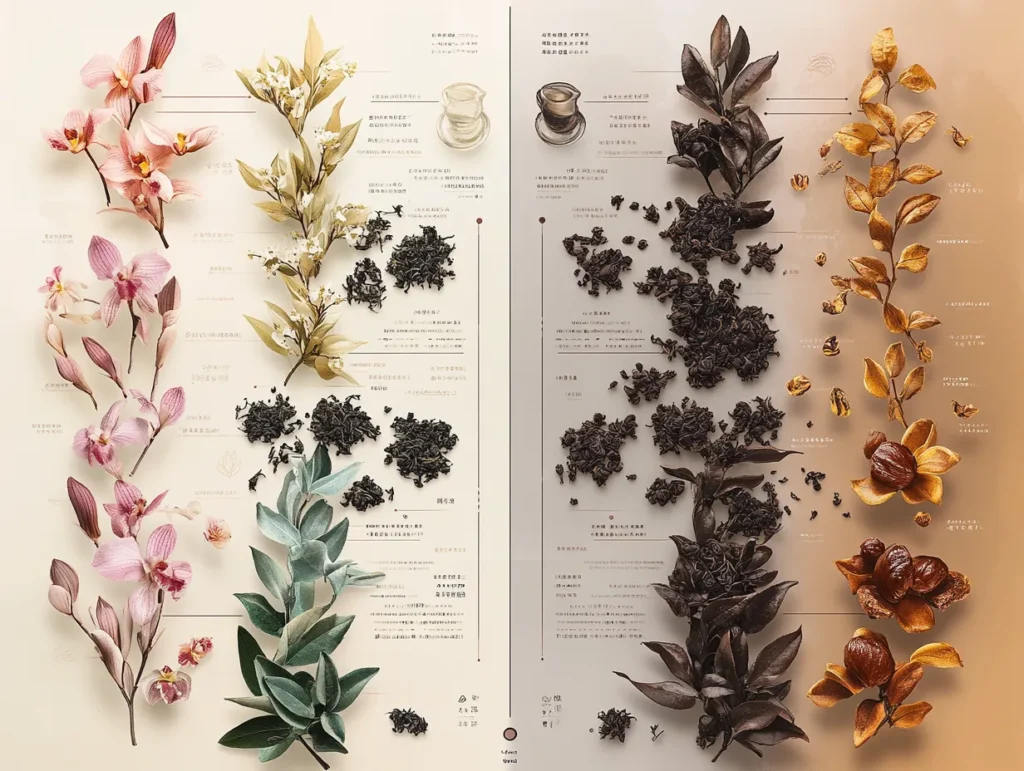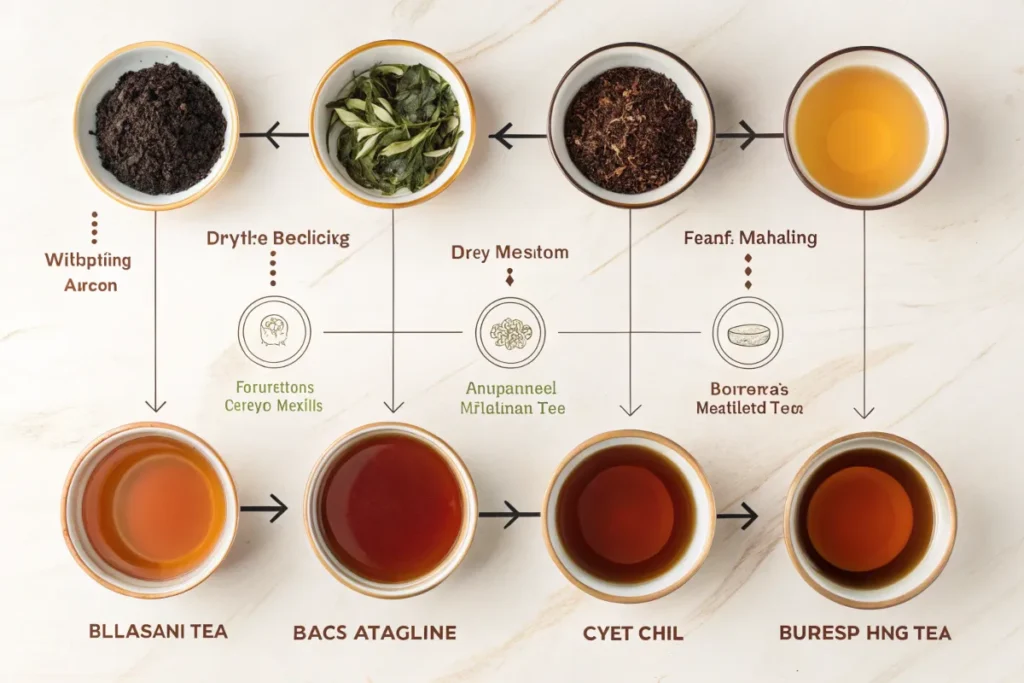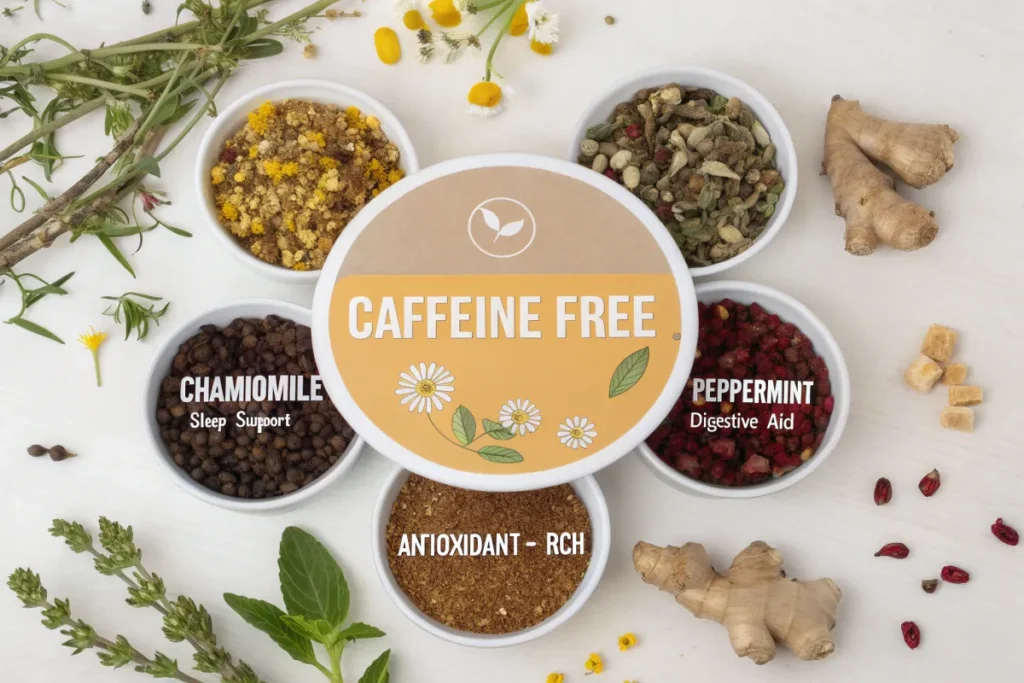Tea is more than just a beverage—it’s a global tradition, a symbol of hospitality, and a source of wellness. Originating in China thousands of years ago, tea has woven itself into the fabric of cultures worldwide. From the delicate notes of white tea to the bold flavors of black tea, each variety offers a unique experience.
This article explores the different kinds of tea, their origins, processing methods, and health benefits. Whether you’re a seasoned tea enthusiast or just beginning your journey, this guide will introduce you to the vast world of tea.
Table of Contents
- Introduction to Tea: Origins and Cultural Significance
- Camellia Sinensis: The Source of True Teas
- White Tea: The Purest Form
- Green Tea: A Staple of Wellness
- Oolong Tea: The Art of Partial Oxidation
- Black Tea: Bold and Robust
- Pu-erh Tea: The Fermented Treasure
- Herbal Teas: Beyond Camellia Sinensis
- Health Benefits of Tea Consumption
- FAQs
- Conclusion
Introduction to Tea: Origins and Cultural Significance
Tea has been enjoyed for over 5,000 years, making it one of the oldest beverages in human history. Legend credits its discovery to Chinese Emperor Shen Nong, who, according to folklore, accidentally brewed tea leaves in hot water around 2737 BCE. Since then, tea has evolved into a staple drink across Asia, the Middle East, Europe, and beyond.
A Beverage That Shaped Cultures
From Japanese tea ceremonies to British afternoon tea, different cultures have embraced tea uniquely. In China, tea drinking is an art form, closely tied to philosophy and meditation. In India, spiced masala chai is a daily ritual. Meanwhile, Moroccan mint tea represents hospitality and friendship.
A Global Industry with Regional Specialties
The tea industry spans continents, with different regions specializing in various kinds of tea:
- China: The birthplace of tea, known for its green, oolong, and pu-erh teas.
- Japan: Famous for its steamed green teas like matcha and sencha.
- India: Home to Assam and Darjeeling black teas, as well as spiced chai.
- Sri Lanka (Ceylon): Produces brisk and bold black teas.
- Taiwan: The go-to destination for high-quality oolong tea.
- Africa (Kenya, Malawi, Rwanda): Emerging as a strong player in black tea production.
Tea’s versatility has led to a growing market for specialty teas, herbal infusions, and blends, making it accessible to all kinds of consumers.
Stay tuned as we dive deeper into the different types of tea, starting with Camellia Sinensis, the plant responsible for all true teas.
Camellia Sinensis: The Source of True Teas
Tea lovers often don’t realize that all true teas—whether white, green, oolong, black, or pu-erh—come from the same plant: Camellia sinensis. The magic lies in how the leaves are processed, which determines the tea’s flavor, aroma, and health benefits.
Varieties of Camellia Sinensis
The Camellia sinensis plant has two primary varieties, each playing a key role in different kinds of tea:
- Camellia sinensis var. sinensis – This variety is native to China and produces teas with delicate flavors, commonly used for white, green, and oolong teas.
- Camellia sinensis var. assamica – Originating in India’s Assam region, it has larger leaves and is used for black teas due to its bold, malty profile.
Certain specialty teas, such as Darjeeling, often combine elements of both varieties, creating complex flavors.
Cultivation and Harvesting
Tea thrives in regions with warm temperatures, high humidity, and well-drained soil. The terroir—altitude, rainfall, and soil type—affects the flavor. For instance:
- High-altitude teas, such as Darjeeling, develop floral, muscatel notes.
- Lowland teas, like Assam, tend to be stronger and more robust.
The leaves are harvested by hand to ensure quality, typically in flushes (harvesting periods). First flush teas, picked in early spring, are prized for their delicate taste, while later flushes produce stronger brews.
Understanding Camellia sinensis helps tea enthusiasts appreciate how minor changes in processing create a world of flavors.
White Tea: The Purest Form

White tea is the least processed of all kinds of tea, preserving its natural sweetness and delicate flavors. Made from young buds and leaves, it undergoes minimal oxidation, resulting in a light, refreshing brew.
Processing Method
Unlike other teas, white tea is not rolled or oxidized. Instead, it is:
- Plucked – Harvested when the buds are covered in fine white hairs.
- Withered – Left to dry naturally in sunlight or controlled indoor environments.
- Dried – Some varieties undergo light roasting to reduce moisture further.
This gentle process maintains high levels of antioxidants, making white tea one of the healthiest tea options.
Flavor Profile and Health Benefits
White tea has a mild, sweet taste with floral and honey-like undertones. The most popular varieties include:
- Silver Needle (Bai Hao Yin Zhen) – Made from only young buds, offering a delicate, silky brew.
- White Peony (Bai Mu Dan) – Includes both leaves and buds, resulting in a fuller-bodied cup.
Health benefits include:
✅ High in antioxidants – Helps combat free radicals and support immune health.
✅ Boosts skin health – Promotes collagen production, reducing signs of aging.
✅ Supports heart health – May help lower blood pressure and improve circulation.
For tea lovers seeking a light yet nutritious option, white tea is a perfect choice.
Green Tea: A Staple of Wellness
Among the many kinds of tea, green tea stands out for its refreshing taste and numerous health benefits. Popular across Asia and beyond, it is known for its grassy, umami-rich flavor and vibrant green color.
Processing and Varieties
Green tea undergoes minimal oxidation, preserving its natural color and flavor. The key steps in processing include:
- Plucking – Fresh leaves are harvested by hand.
- Withering – Leaves lose moisture to enhance flavor.
- Fixation (Steaming or Pan-Firing) – This step prevents oxidation. Japanese teas like Sencha are steamed, while Chinese teas like Dragon Well (Longjing) are pan-fired.
- Rolling and Drying – The leaves are shaped and dried to lock in flavors.
Some of the most famous green teas include:
- Matcha – A powdered Japanese green tea known for its rich, creamy texture.
- Gunpowder Green Tea – A tightly rolled tea from China with a bold, smoky flavor.
- Sencha – The most common Japanese green tea with a fresh, grassy taste.
Health Benefits
Green tea is packed with antioxidants, particularly catechins like EGCG, which help reduce oxidative stress. Other benefits include:
✅ Boosts metabolism – May aid in weight management by increasing fat burning.
✅ Supports heart health – Helps lower cholesterol and regulate blood pressure.
✅ Enhances brain function – Contains L-theanine, which improves focus and reduces stress.
Whether enjoyed hot or iced, green tea is a go-to beverage for those seeking a healthy and flavorful drink.
Oolong Tea: The Art of Partial Oxidation

Oolong tea, often described as the bridge between green and black teas, is semi-oxidized, offering a wide range of flavors from floral and fruity to rich and roasted.
Processing Techniques
Oolong tea’s unique taste comes from its carefully controlled oxidation. The process includes:
- Withering – Freshly plucked leaves are spread out to soften.
- Bruising – Leaves are gently shaken or tossed to promote oxidation.
- Oxidation – This varies from 10% to 80%, affecting the flavor and color.
- Firing – Leaves are pan-fired or baked to halt oxidation.
- Rolling and Drying – The leaves are tightly rolled or twisted to develop complex aromas.
Flavor Profile
Depending on the oxidation level, oolong tea can taste:
- Light and floral – Examples include Tie Guan Yin (Iron Goddess of Mercy), which has orchid-like notes.
- Rich and roasted – Da Hong Pao (Big Red Robe) is a famous Chinese oolong with deep, toasty flavors.
Health Benefits
Oolong tea is prized for its ability to balance energy and relaxation. It offers:
✅ Supports digestion – Helps with gut health and reducing bloating.
✅ Promotes weight loss – Increases fat oxidation and metabolism.
✅ Improves mental alertness – Contains caffeine and L-theanine for sustained energy.
For tea lovers seeking complexity and depth, oolong tea is an excellent choice.
Black Tea: Bold and Robust

Among all kinds of tea, black tea is the most oxidized, giving it a deep, rich flavor and dark color. It is a favorite worldwide, enjoyed plain or blended with spices, milk, or sweeteners.
Processing and Varieties
The production of black tea involves full oxidation, which develops its strong, malty taste. The process includes:
- Withering – Fresh leaves are spread out to remove moisture.
- Rolling – Leaves are twisted or cut to release natural enzymes.
- Oxidation – Leaves darken as they react with oxygen.
- Firing and Drying – The oxidation process is stopped by heat.
Some of the most popular black teas include:
- Assam – A bold Indian tea with a malty flavor, often used in breakfast blends.
- Darjeeling – Grown in the highlands of India, it has floral and muscatel notes.
- Ceylon Tea – From Sri Lanka, it is bright and citrusy.
- Earl Grey – A black tea infused with bergamot oil, giving it a citrusy aroma.
Cultural Significance
Black tea is deeply ingrained in many cultures. In Britain, it is the foundation of afternoon tea. In India, it is used to make masala chai, a spiced tea with milk and sugar. Meanwhile, Turkish tea is strong and served in small glasses without milk.
Health Benefits
Black tea contains antioxidants and caffeine, offering several health perks:
✅ Boosts energy – A good alternative to coffee with less caffeine.
✅ Supports heart health – May help reduce cholesterol and blood pressure.
✅ Improves digestion – Black tea’s tannins aid in gut health.
With its strong flavors and versatility, black tea remains one of the most popular kinds of tea worldwide.
Pu-erh Tea: The Fermented Treasure
Unlike other kinds of tea, pu-erh tea undergoes fermentation, which deepens its complexity over time. This aging process gives pu-erh a rich, earthy taste, making it unique among teas.
Processing and Aging
Pu-erh tea is produced mainly in Yunnan, China, using large-leaf tea plants. The two main types are:
- Raw (Sheng) Pu-erh – Naturally aged over years, developing a smooth, mellow taste.
- Ripe (Shou) Pu-erh – Aged quickly through controlled fermentation, offering a deep, earthy flavor.
The process involves:
- Sun-drying – Leaves are dried naturally.
- Compression (for cakes or bricks) – Some pu-erh teas are shaped into discs or bricks for aging.
- Aging – Can last from months to decades, allowing flavors to mature.
Health Benefits
Pu-erh tea is highly valued for its digestive and detoxifying properties:
✅ Aids digestion – Helps break down heavy foods.
✅ Lowers cholesterol – Studies suggest it may help reduce LDL cholesterol.
✅ Supports gut health – Contains natural probiotics from fermentation.
Pu-erh is often enjoyed after a rich meal, making it a favorite for those seeking a soothing, earthy tea with health benefits.
Herbal Teas: Beyond Camellia Sinensis

While true teas come from the Camellia sinensis plant, herbal teas (also called tisanes) are made from flowers, herbs, fruits, and spices. Unlike other kinds of tea, herbal infusions are naturally caffeine-free, making them a great choice for relaxation.
Popular Herbal Infusions
Herbal teas come in many varieties, each offering unique flavors and benefits. Some of the most popular include:
- Chamomile Tea – A calming tea with floral notes, often used to promote sleep.
- Peppermint Tea – Known for its refreshing taste and ability to ease digestion.
- Rooibos Tea – A naturally sweet, earthy tea from South Africa, rich in antioxidants.
- Hibiscus Tea – A tart, ruby-red infusion that may help lower blood pressure.
- Ginger Tea – Spicy and warming, often used for nausea and digestion.
Health Benefits
Since herbal teas contain vitamins, antioxidants, and plant compounds, they offer many health benefits:
✅ Supports digestion – Ginger and peppermint tea help with bloating and nausea.
✅ Boosts immunity – Echinacea and elderberry tea may help prevent colds.
✅ Reduces stress – Chamomile and lavender teas promote relaxation.
Herbal teas are an excellent choice for those seeking flavorful, caffeine-free alternatives to traditional teas.
Health Benefits of Tea Consumption
Drinking tea isn’t just about enjoying different flavors—it’s also packed with health benefits. Various kinds of tea contain antioxidants, polyphenols, and essential nutrients, all of which contribute to overall well-being.
Antioxidant Properties
Tea is one of the best sources of antioxidants, which help combat free radicals and reduce cell damage. Different teas offer unique benefits:
- White tea – Has the highest level of antioxidants, helping with skin health.
- Green tea – Rich in catechins, which may reduce inflammation and improve heart health.
- Black tea – Contains theaflavins, which support cholesterol and blood pressure control.
Regular consumption of tea may reduce the risk of chronic diseases like heart disease, diabetes, and even certain cancers.
Caffeine Content and Effects
Most kinds of tea naturally contain caffeine, but in varying amounts:
- Black tea – Highest caffeine content, providing an energy boost.
- Green and oolong tea – Moderate caffeine levels, offering alertness without jitters.
- White tea – Lower in caffeine, making it a gentle option.
- Herbal teas – Naturally caffeine-free and ideal for relaxation.
Tea’s caffeine content, combined with L-theanine, provides calm alertness—enhancing focus without the crash of coffee.
By choosing the right tea, drinkers can enjoy both flavor and health benefits, making tea one of the most versatile beverages in the world.
For more on caffeine-free options, explore our guide to herbal tea varieties .
FAQs About Tea
Many tea drinkers have questions about the different kinds of tea, their benefits, and the best ways to enjoy them. Here are some commonly asked questions.
1. Which tea is the healthiest?
Each tea has unique health benefits. Green tea is often considered the healthiest because of its high antioxidant content. However, white tea has even more antioxidants, while herbal teas like chamomile and ginger can support digestion and relaxation.
2. Does tea have more caffeine than coffee?
No, tea generally has less caffeine than coffee. Black tea has the highest caffeine content among teas, with about 40–70 mg per cup, while coffee has 90–120 mg per cup. If you want a low-caffeine option, try white or herbal teas.
3. What is the best tea for weight loss?
Green tea and oolong tea are known to boost metabolism and fat oxidation, making them great choices for weight management. Pu-erh tea may also aid digestion and help break down fats.
4. Can you drink tea every day?
Yes! Drinking tea daily can support heart health, digestion, and mental clarity. However, excessive caffeine intake from black or green tea may cause jitteriness in sensitive individuals. Herbal teas are a great caffeine-free alternative for daily consumption.
Conclusion
Tea is one of the most versatile and beneficial beverages in the world. From the delicate white tea to the bold flavors of black tea, each type offers a unique experience. Whether you prefer the calming effects of chamomile or the energy boost of green tea, there’s a tea for every occasion.
With a wide variety of kinds of tea to explore, tea lovers can enjoy both taste and health benefits. So, whether you’re sipping a steaming cup on a cold day or enjoying a refreshing iced tea in summer, you’re partaking in a tradition that has spanned thousands of years.
Now that you know more about the different types of tea, which one will you try next?

